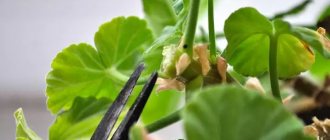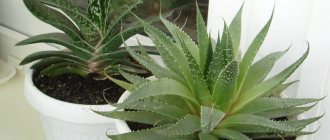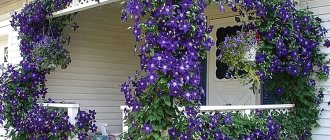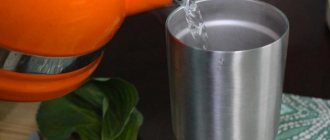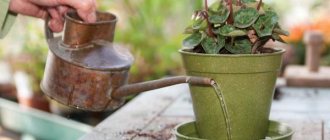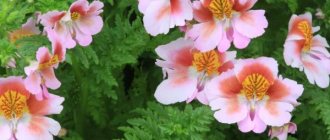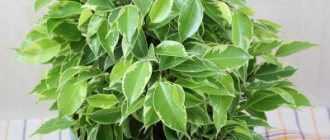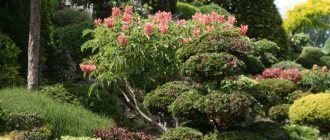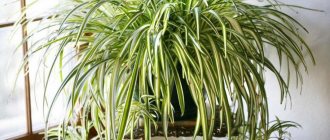Castanospermum is a very spectacular plant that inspires surprise and attracts the attention of all visitors to the house. The most recognizable parts are the two large seed cones, resembling two halves of a chestnut, with the main shoot growing between them. This crop is often called chestnut seed or chestnut sapling, and is known to some as chestnut tree. Those who want to have this plant at home must know how to care for it at home.
general description
Despite the familiar name, it is not related to the real chestnut tree. Castanospermum is a leguminous plant.
In the wild, the plant is found on the east coast of Australia, from where it came to Europe as a greenhouse specimen and then spread throughout the world as a houseplant. Its habitat is the tropics with high humidity. In the wild it always grows as a tree and its growth rate is astonishing, usually reaching 10 m in height in a few years.
From the third year it blooms with yellow or red inflorescences, which open from May to August. After flowering, long, pod-like fruits with ripe seeds inside ripen.
Castanospermum is a tree with a thick, openwork crown. The branches are covered with narrow long leaves that flutter beautifully in the wind. The edge of the leaf blade is wavy, and the entire surface is glossy, making the chestnut look very decorative. In the wild, the lifespan of a tree is 50-150 years.
The Aborigines used chestnut bark as food after boiling it, but today eating any part of the chestnut tree is not practiced.
Will this chestnut tree bloom?
At the mention of chestnut, every person’s imagination pictures beautiful snow-white fragrant clusters of flowers. Australian chestnut flowers differently. Its flower has nothing in common with its European counterpart. The fruits are a little similar. That is why it was called chestnut.
What an Australian chestnut flower looks like can only be seen in the wild in November and December. These months are the spring-summer period in Australia. Bright orange flowers with long stamens form large inflorescences, filling the surrounding space with a pleasant aroma.
It looks quite beautiful. There is not a single case known of an Australian chestnut flowering at home.
Indoor chestnut is intended for those people who prefer lush greenery at home. For this purpose, such a decorative flower is perfect.
Important! The fragrant flowers of the Australian chestnut are pollinated not by insects, but by bats.
The powerful root system, beautiful color and appearance of the plant have made it popular for use in decorative landscaping of private plots, city streets, as well as for strengthening slopes from landslides.
Home care type
Only one type is always used in home care - southern chestnut spermum. It is not able to achieve the same parameters as in nature. Most often, the flower grows up to 70-80 cm. Its size is limited by the volume of the pot, so if it is planted in a huge tub, then in a greenhouse it can grow up to 3.5 m.
Even with very good care, the chestnut tree cannot be expected to bloom. Flowering is hampered by the lack of volume for the root system, so the appearance of flowers at home is considered a rare occurrence.
It is important to note that chestnut seeds should not be kept in homes where there are small children, since the juice from all parts of this plant causes rashes, allergies, chemical burns, and the most severe consequences can occur after ingestion of its leaves or pieces of branches. Negative effects are due to the presence of saponins, which are aggressive to the human body.
Uses of Australian chestnut
Used for landscaping streets and decorating garden plots. Wild chestnut wood is very durable. Used for furniture production, carvings, paneling and other carpentry. A powerful root system serves to strengthen soils from erosion. The seeds are poisonous, but become edible when soaked in water, fried and ground into flour.
A miniature, unusual chestnut in a pot is an interior decoration.
See home chestnut in the photo:
Growing rules
Growing and caring for castanospermum is simple and can be done by the most inexperienced gardeners. The most important thing is to make the flower as close to its natural habitat as possible.
Temperature
The chestnut flower is a flower whose temperature regime is seasonal. This means that temperatures should vary from season to season, although in general this crop is heat-loving.
During active growth, when castanospermum is actively growing, the temperature should be maintained at 20-25°C. At higher temperatures, the plant suffers from heat and may respond by suddenly stopping growth, dropping leaves, and generally deteriorating. The period of active growth usually begins in March-April and lasts until August-September.
By the end of summer, the temperature should be gradually reduced to 14-16°C. At the same time, there is a gradual transition to a dormant period, when new leaves and branches are not formed. It is important that the room temperature does not fall below 12°C, as such low temperatures are fatal for this heat-loving plant. For this reason, do not leave them on unheated porches or hallways.
Lighting
Xanthospermum is a light-loving flower. It needs enough light to grow, otherwise it will have thin branches and long internodes. To properly care for the plant, place it on an east or west windowsill where there will be plenty of light but where the leaves will not be exposed to direct sunlight. If the only space available is on the sill of a south-facing window, use an artificial cover to prevent thermal burn of the crown.
During the winter months, chestnut spermaceti may lack light due to short daylight hours. This will be understandable due to the gradual loss of leaves. To stop the loss of leaves, care can be supplemented with phytolamps or fluorescent lamps. Daylight hours for this crop should be at least 12-16 hours.
Place
It is very important to provide the plant with a suitable place where there are no drafts and winds that damage the root system. During the summer months it is a good idea to place the pot outside. In the garden, Castanospermum shows a very good growth rate and behaves very well. The only thing you need to watch out for is to avoid direct sunlight.
Watering
Use only softened water without hardness. Use settled water, but preferably rain or melt water.
The method of watering also depends on the time of year. In summer, moisture evaporates faster due to higher temperatures, so water more often. The topsoil may provide a clue. Proper care means that the next watering should be done when the top layer of soil has dried out 3-4 cm. You can check this by plunging your finger into the soil.
In winter, when they are kept in a cooler environment, the need for moisture and the frequency of watering decrease sharply. During this season, you can allow the soil to dry out more. As a general rule, systematic overwatering is more harmful than slight dryness.
After watering, wait until water appears in the saucer and then leave the pot to allow the soil to soak. After 20-30 minutes, remove any remaining moisture.
Air humidity
The parameter that causes the most errors when caring for chestnuts at home is humidity. In the wild, this plant prefers places near natural bodies of water, so it needs high humidity.
To recreate the same conditions at home, you can choose the most suitable method. Spraying with a fine spray nozzle provides excellent results. A shower can be arranged, but only if the surface of the pot is covered with a film that will protect the soil from excessive moisture. Another method is to place the pot of castanospermum in a tray with damp moss or stones in water. It is important to ensure that the water level in the pan does not touch the bottom of the pan. In all these cases, the water should be at room temperature or a few degrees warmer, but do not use cold or hot water.
In winter, if the plant is kept in a cool room, spraying cannot be carried out, since there is practically no evaporation from the leaves.
Feeding
Castanospermum at home is very sensitive to fertilizer, but certain rules must be followed. Fertilizer application should begin no earlier than a month after transplanting the plant into new soil. Before adding the nutrient solution, the soil should be moistened so that the root system is not subject to chemical burns. Fertilization should be carried out the day before.
Fertilizing castanospermum with organic complexes for decorative deciduous indoor plants. During the active period, the frequency of fertilizer application is once every two weeks, but in the autumn this frequency gradually decreases. During the rest period, the dose is halved, and the frequency of use should not exceed once a month.
For this flower, not only root feeding is suitable, but also spraying the solution on the leaf. The intervals will remain the same.
Transfer
The transplant is carried out immediately after the flower is brought from the store, if it was planted in a transport medium. Then pay attention to the condition of the cotyledons. Once they are dry and dry, the soil in the pot should be replaced. The embryos should not be pulled out; they should fall off on their own.
Then repot the plant approximately every 2-3 years, depending on the plant's growth rate and the size of the root system. If the home container in which Cassanospermum is growing is too large and a complete replanting is not possible, it is recommended to replace 2/3 of the old soil with new one. Both replanting and replacement of one layer should be carried out at the beginning of spring activity, in late March - early April.
The soil
A slightly acidic substrate is ideal for growing this plant at home. The best pH is in the range of 5.5-5.9. You can use commercially available fig tree soil.
Those who want to give the flower the perfect composition should prepare their own substrate from the following ingredients:
- 1 part leaf soil;
- 1 part of turf land;
- 1 part coarse river sand.
- 1 part finely ground peat;
To increase soil permeability, you can add some crushed pine bark.
An important nuance is that every year the need for castanospermum in organic substances increases, so the proportion of turf soil should increase each time in order to ensure normal care at home and preserve the decorative appearance of the flower.
Watering the plant
From spring to autumn, chestnutspermum requires abundant watering without drying out the earthen clod. Water for irrigation must be settled so that it becomes soft. In winter, water less frequently, allowing the soil in the pot to dry out, but not overdry. In general, chestnut tolerates a lack of water more easily than its excess. By flooding a plant, you risk losing it, as the root system will gradually begin to rot and the chestnut will die. So act carefully, otherwise you yourself, due to inexperience, will ruin the plant.
In nature, this plant often grows along the banks of rivers, so it loves moist air very much. Regular spraying and warm showers have a very beneficial effect on the growth and development of indoor chestnut.
Spraying is carried out with settled warm water. This is especially true in winter, since heating makes the air completely dry. Chestnut begins to suffer from dry air, and a warm shower every day will become a real holiday. Just remember that under no circumstances should you place the plant next to radiators. Droplets of water that remain on the leaves can cause inconvenience to the plant, as they will lead to burns. For the same reason, it must be hidden from the sun in summer. It grows well outdoors, but again requires shelter from direct sunlight.
Reproduction
There are two main methods of propagation: seeds and cuttings. Almost anyone can propagate by seeds, while propagation by cuttings requires certain skills.
Seminal
The seeds are difficult to obtain at a flower shop, but can be ordered online. Before sowing, it is necessary to prepare the material for planting. Soak the seeds for one day in warm water, and after cooling, change the water periodically.
Planting is carried out in the first half of spring. Seeds are sown in a slightly moistened mixture of sand and peat. The planting box is covered with transparent polyethylene. Place the box in a warm, bright place for germination.
Ventilate the room daily and remove drops of condensation, and water the soil if necessary. It will take almost a year for seeds to germinate at home, so you will see the first shoots only next spring. As soon as the first shoots appear, remove the plastic film so that the shoots become accustomed to the conditions in the house.
When the young sprouts have three full leaves, they are transplanted into separate containers, and after some time they are transferred to permanent pots.
Lighting
Indoor chestnut prefers bright, diffused lighting; during the daytime it must be shaded from direct sunlight. It feels good on eastern and northwestern window sills and loggias. Sunlight in the morning and evening is quite enough for the plant. It is these sides in the apartment that will give the plant the necessary diffused lighting that it loves.
Direct sunlight is destructive for the plant: the delicate crown will quickly get burned, which will adversely affect its development. But lack of light is not the best option. The leaves will become faded and dull.
In the summer, the chestnut can be taken out into the open air, having first protected the place from direct sunlight.
Diseases and pests
Australian chestnut is quite resistant to diseases and pests, which affect most domestic flowers.
If dry spots appear on the chestnut pages, or they turn yellow and fall off, this indicates that the care is not correct.
Very dry air space or excessive watering. Based on this, you need to follow all the rules for caring for this plant and troubles can be avoided. From time to time, a spider mite or scale insect may appear on a tree; these problems can be easily removed using products that can be purchased at any gardening store.
How to plant
The best time for planting is the end of winter - the beginning of spring. In rare cases, autumn planting is practiced. The nuts do not have time to dry out and do not require long-term storage in the sand. But to guarantee germination, chestnuts still need to undergo stratification.
Requirements for pot and soil
The first container for chestnut is taken with a volume of up to 0.5 liters. You can plant several nuts at once, then it is better to take a planting container of sufficient volume, and then plant the seedlings in separate pots. There must be holes at the bottom for drainage. The plant has no special soil requirements. You can buy a ready-made universal soil mixture for garden crops. At the time of planting, it should be well moistened.
Landing rules
Place a drainage layer of expanded clay or broken brick at the bottom of the planting pot. 2 weeks before planting, the nuts need to be transferred from a cool room to a warm one, softening the shell. Chestnuts without sprouts are discarded. Plant suitable planting material into the soil to a depth of 5 cm. Shoots will appear in approximately 3 weeks. In order for the air to feed the nuts unhindered, it is necessary to regularly loosen the soil and water it moderately.
Choosing a location for a tree
Chestnuts like space and good lighting from all sides. Choose a place for them at a distance of 7-10 meters from buildings, fences and about 5 meters on each side. Please note that the plant needs protection from drafts. An ideal place for relaxation in the summer is to place a children's playground under the thick crown of a tree, install a table with benches, and hang a hammock. Even herbs grow poorly in its dense shade, and even more so flowers. Chestnuts love loamy and chernozem soils. When planting in loamy soils, add sand to the holes, and in loose soils add a little clay.
Varieties
Horse chestnut is the most common type of this plant. In addition to it, other species are grown:
- California chestnut. This species is native to western North America. The height of the tree reaches 10 meters. It has a straight trunk. The main advantage of the tree is its white flowers with a pinkish tint, reaching a diameter of 20 centimeters;
- meat-red chestnut. Distributed in Crimea, the south of the Baltic states, and Ukraine. An adult plant can grow up to 25-30 meters. The leaves are dark green in color, with a dense, leathery surface. The flowers are collected in racemes and are dark pink or dark red. This chestnut variety needs a lot of moisture and does not tolerate hot, dry summers;
- yellow chestnut. The chestnut variety is widespread in the eastern part of America. A tree up to 30 meters high has a pyramid-shaped crown. The leaves are wedge-shaped with serrated edges. The lower part of the leaf blade is painted golden yellow. This variety of plant tolerates lower temperatures in winter more easily than others and blooms somewhat later than other species;
- small-flowered chestnut. Unlike other representatives of this species, it has a bushy form and reaches a height of 5 meters. Planting small-flowered chestnut can create dense thickets. The leaves consist of several small leaflets, the lower part of which has a grayish tint;
- Pavia or red chestnut. It grows in the eastern United States. The plant can have a woody or shrubby form. Its height reaches 10-20 meters. The flowers are painted a rich red color. The fruits are smooth and have no bristles;
- Japanese chestnut. The height of the tree is 30 meters. The trunk is straight, smooth, the main branches are spreading. The leaves are quite large, reaching a length of 16 centimeters. The flowers are yellowish-white and collected in inflorescences. The fruits are pear-shaped.
How to choose a nut for planting
Nuts for planting can only be taken from the ground. If they are still on the tree, they are still growing and are not yet ripe. Therefore, it is impossible to grow chestnuts from them. The best time to collect nuts is September or October (depending on specific climatic conditions).
Carefully inspect the surface of the planting material. It should be smooth, without cracks or other damage. It should not feel soft. It is better to collect chestnuts under trees with a massive trunk. Take the number of nuts several times more than necessary, since not all of them will germinate (on average, 1-2 trees grow out of 5 pieces).
